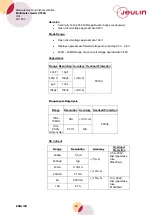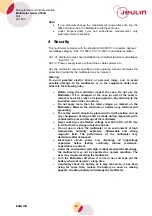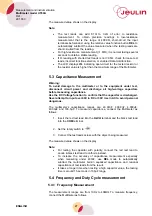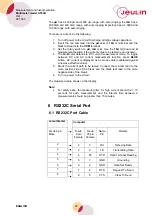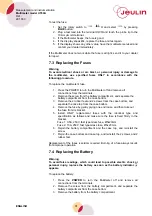
Measurement and instrumentation
Multimeter model UT60A
Réf :
291 033
ENGLISH
25
5 Measurement Operation
5.1 AC & DC Voltage Measurement
Warning:
To avoid harms to you or damages to the multimeter from electric shock,
please do not attempt to measure voltages higher than 1000V
/
750V rms
although readings may be obtained.
5.1.1 AC Voltage Measurement
The AC voltage ranges are: 4.000V, 40,00V, 400.0V and 750.0V. To measure
AC Voltage, connect the Multimeter as follows:
1. Insert the red test lead into the
HzV
Ω
terminal and the black test lead
into the
COM
terminal.
2. Set the rotary switch to
HzV
and press
BLUE
button to select AC
measurement mode.
3. Connect the test leads across with the abject being measured.
The measured value shows on the display, which is effective value of sine
wave (mean value response).
Note:
•
In each range, the multimeter has an Input Impedance of 10M
Ω
. This
loading effect can cause measurement errors in high Impedance
circuits. If the circuit Impedance is less than or equal to 10k
Ω
, the error
is negligible (0.1% or less).
5.1.2 DC Voltage Measurement
The DC Voltage ranges are: 400.0mV, 4.000V, 4000V, 400.0Vand 1000V. To
measure DC voltage, connect the Multimeter as follows:
1. Insert the red test lead into the
HzV
Ω
terminal and the black test lead
into the
COM
terminal.
2. Set the rotary switch to
HzV
, DC measurement is default or press
BLUE
button to select DC measurement mode.
3. Connect the test leads across with the object being measured.
The measured value shows on the display.
Note:
•
ln each range, the multimeter has an input Impedance of 10M
Ω
. This
loading effect can cause measurement errors in high Impedance
circuits If the circuit Impedance IS less than or equal to 10k
Ω
, the error
is negligible (0.1 % or less).
5.2 Measuring Continuity, Diodes & Resistance
Warning:
To avoid damages 1.0 the multimeter or 1.0 the devices under test,
disconnect circuit power and discharge ail the high-voltage capacitors
before measuring continuity, diodes & resistance.












